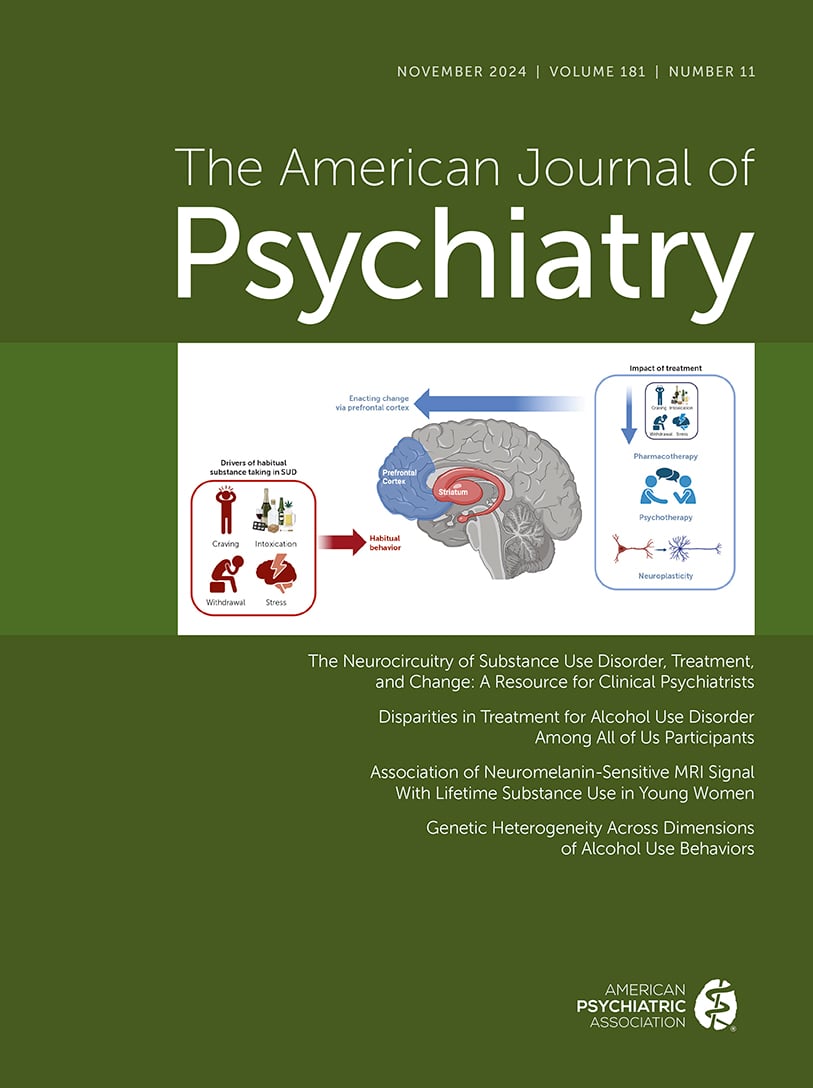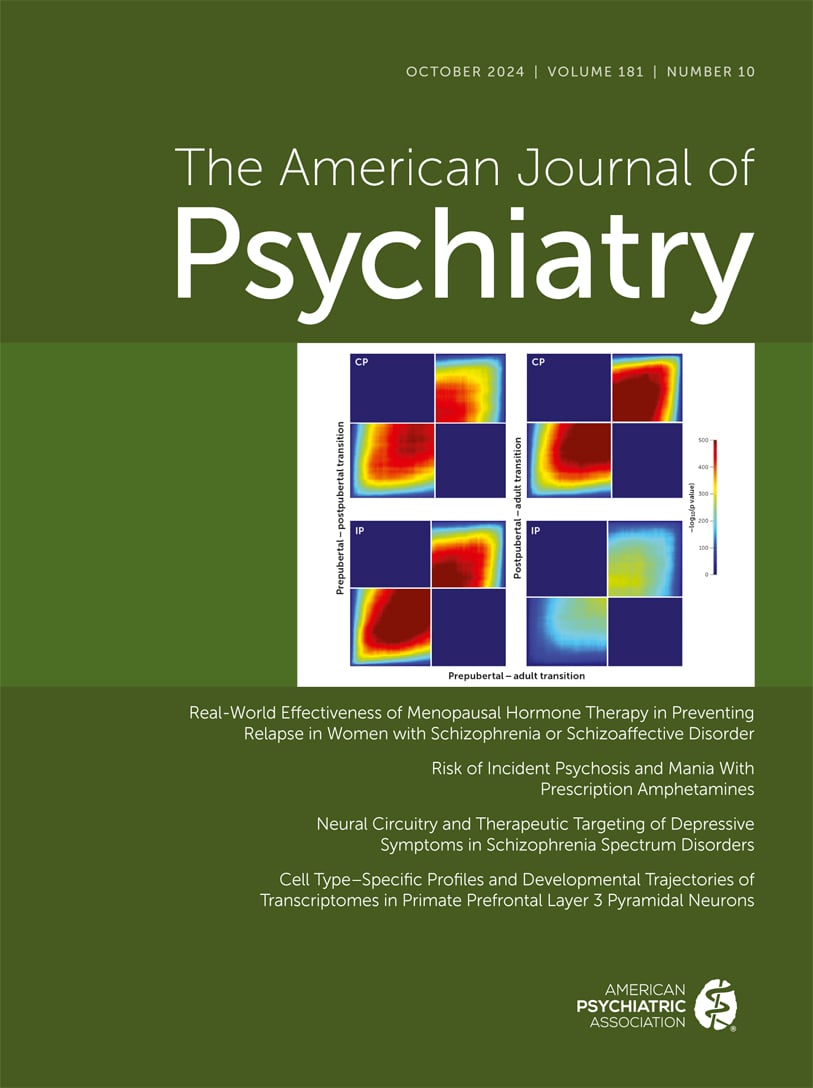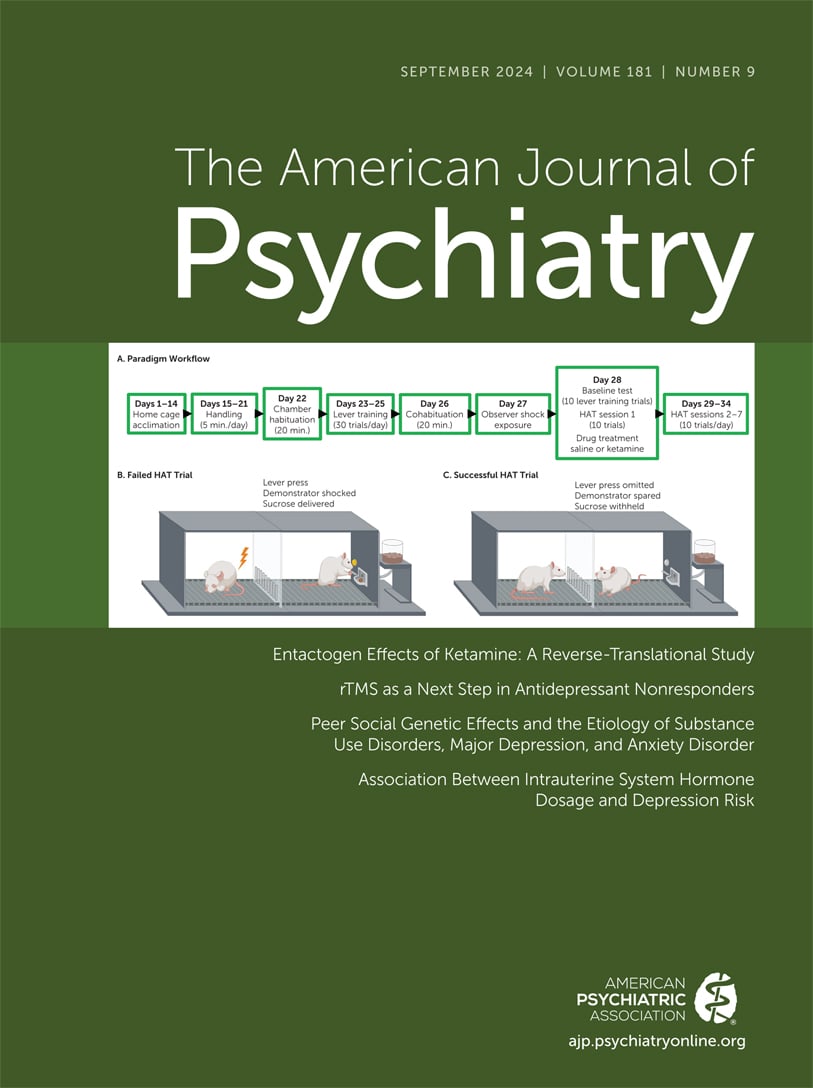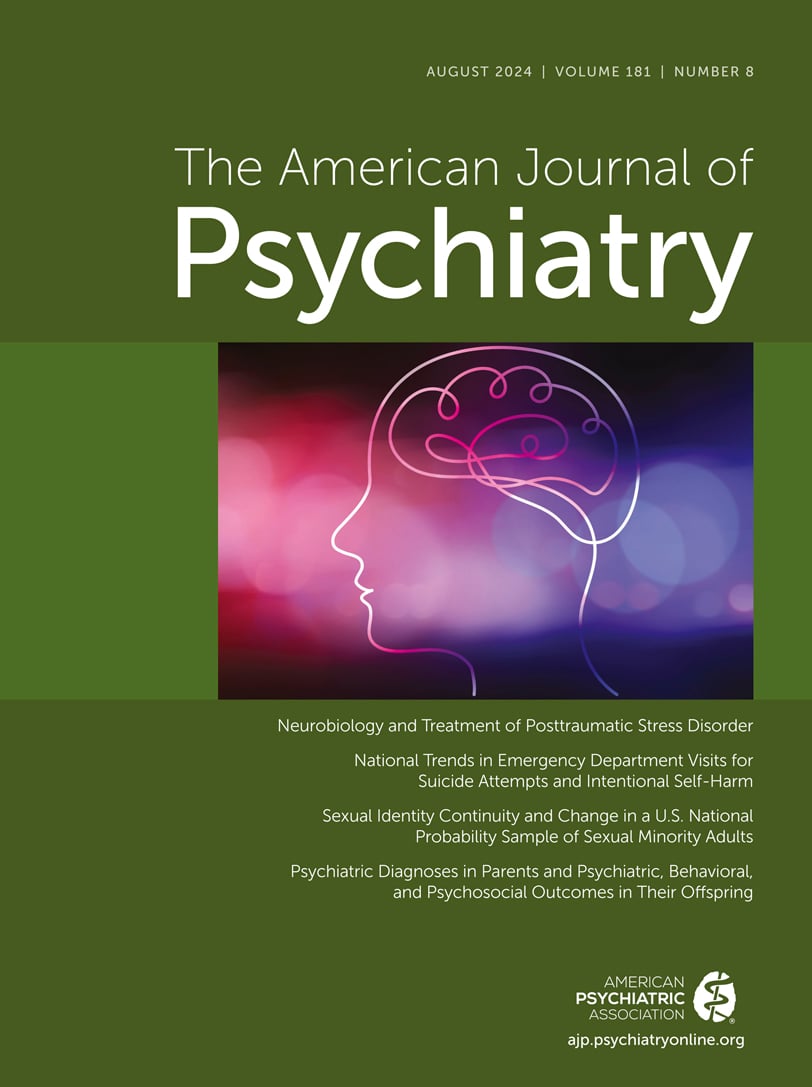American Journal of Psychiatry
- Volume 158
- Number 1
- January 2001
Editorial
Reviews and Overviews
Publication date: 01 January 2001
Pages4–10OBJECTIVE: The authors sought a rational approach to implementing informed consent within the practice of psychotherapy. METHOD: The history of informed consent in psychotherapy was reviewed to define a common synthesis that maximizes the potential ...
https://doi.org/10.1176/appi.ajp.158.1.4Publication date: 01 January 2001
Pages11–20OBJECTIVE: The imaging of brain activity with positron emission tomography (PET) and functional magnetic resonance imaging has assumed a central position in psychiatry. Functional imaging signals arise from changes in the neurophysiological parameters of ...
https://doi.org/10.1176/appi.ajp.158.1.11Images in Neuroscience
Clinical Case Conference
Images in Psychiatry
Article
Publication date: 01 January 2001
Pages29–35OBJECTIVE: Lack of adherence to diabetic self-management regimens is associated with a high risk of diabetes complications. Previous research has shown that the quality of the patient-provider relationship is associated with adherence to diabetes ...
https://doi.org/10.1176/appi.ajp.158.1.29Publication date: 01 January 2001
Pages36–42OBJECTIVE: The aim of this study was to determine whether the substantial gains made by patients with borderline personality disorder following completion of a psychoanalytically oriented partial hospitalization program, in comparison to patients treated ...
https://doi.org/10.1176/appi.ajp.158.1.36Publication date: 01 January 2001
Pages43–48OBJECTIVE: The authors’ objectives were to determine 1) whether major depressive disorder diagnosed according to DSM-IV criteria modified for the medically ill predicted in-hospital mortality better than major depressive disorder diagnosed according to ...
https://doi.org/10.1176/appi.ajp.158.1.43Publication date: 01 January 2001
Pages49–57OBJECTIVE: The purpose of the study was to evaluate 1) whether an underlying familial predisposition is shared by all anxiety disorders or whether specific risks are associated with specific disorders, and 2) whether panic disorder and major depression ...
https://doi.org/10.1176/appi.ajp.158.1.49Publication date: 01 January 2001
Pages58–67OBJECTIVE: The behavioral response to CO2 inhalation has been used to differentiate panic disorder patients from normal subjects and other clinical populations. This study extended examination of the diagnostic specificity of CO2-induced anxiety by ...
https://doi.org/10.1176/appi.ajp.158.1.58Publication date: 01 January 2001
Pages68–72OBJECTIVE: This study assessed the specificity of depressive symptoms in patients with Alzheimer’s disease and examined the discrepancies between patient and caregiver symptom reports. METHOD: The study group was composed of a series of 233 patients with ...
https://doi.org/10.1176/appi.ajp.158.1.68Publication date: 01 January 2001
Pages73–77OBJECTIVE: This study examined the prevalence of, and association between, childhood abuse and psychiatric disorders in single and married mothers. METHOD: Single and married mothers who participated in the Ontario Health Survey, a province-wide study ...
https://doi.org/10.1176/appi.ajp.158.1.73Publication date: 01 January 2001
Pages78–85OBJECTIVE: In the cortex of animals, serotonin (5-HT) levels increase after several weeks of treatment with selective serotonin reuptake inhibitors (SSRIs). Studies using an intrasubject design to examine the effects of SSRI treatment on 5-HT2A receptors ...
https://doi.org/10.1176/appi.ajp.158.1.78Publication date: 01 January 2001
Pages86–95OBJECTIVE: Identification of brain activity associated with craving is important for understanding the neurobiology of addiction. METHOD: Brain activity was measured in cocaine addicts and healthy subjects by functional magnetic resonance imaging (fMRI) ...
https://doi.org/10.1176/appi.ajp.158.1.86Patients Admitted to Emergency Services for Drunkenness: Moderate Alcohol Users or Harmful Drinkers?
Publication date: 01 January 2001
Pages96–99OBJECTIVE: Most of the patients admitted to hospital emergency services are drunk. Some of them may need specific treatment after acute intoxication remits. At present, treatment for alcoholism is offered to less than 5% of these patients. The authors ...
https://doi.org/10.1176/appi.ajp.158.1.96Publication date: 01 January 2001
Pages100–106OBJECTIVE: Performance on measures of saccadic inhibition and control was investigated in a large family study of schizophrenia to evaluate the utility of using antisaccade task performance as an endophenotypic marker of genetic liability for ...
https://doi.org/10.1176/appi.ajp.158.1.100Publication date: 01 January 2001
Pages107–115OBJECTIVE: Olfactory identification deficits and their relationship to negative symptoms in patients with schizophrenia were examined in patients with recent-onset psychosis, the majority of whom were neuroleptic naive. METHOD: Seventy-four inpatients ...
https://doi.org/10.1176/appi.ajp.158.1.107Brief Report
Publication date: 01 January 2001
Pages116–118OBJECTIVE: There is some evidence of thalamic abnormalities in schizophrenia. This study investigated thalamic volumes in patients experiencing their first episode of psychosis and nonpsychotic comparison subjects. METHOD: Magnetic resonance imaging scans ...
https://doi.org/10.1176/appi.ajp.158.1.116Publication date: 01 January 2001
Pages118–122OBJECTIVE: This study evaluated neurologic functioning in adolescents with schizophrenia with onset of psychosis before age 13. METHOD: The authors administered a structured neurologic examination to 21 adolescents with early-onset schizophrenia and 27 ...
https://doi.org/10.1176/appi.ajp.158.1.118Publication date: 01 January 2001
Pages122–125OBJECTIVE: Deficits in insight have been found in one study to be more common and severe in patients with schizophrenia than in patients with schizoaffective and major depression with and without psychosis but not more severe than they are in patients ...
https://doi.org/10.1176/appi.ajp.158.1.122Publication date: 01 January 2001
Pages125–127OBJECTIVE: The authors’ goal was to conduct an adult follow-up of subjects who had participated in a study of nortriptyline for childhood depression. METHOD: The study group represented 100 (90.9%) of the original 110 subjects and included 72 subjects who ...
https://doi.org/10.1176/appi.ajp.158.1.125Publication date: 01 January 2001
Pages128–130OBJECTIVE: Few studies, with conflicting results, have examined the occurrence of thrombocytopenia with valproate administration. This study assessed whether the platelet-lowering effects of valproate are increased among elderly psychiatric patients. ...
https://doi.org/10.1176/appi.ajp.158.1.128Publication date: 01 January 2001
Pages131–134OBJECTIVE: Treatment-resistant depression is a significant public health concern; drug switching or augmentation often produce limited results. The authors hypothesized that fluoxetine could be augmented with olanzapine to successfully treat resistant ...
https://doi.org/10.1176/appi.ajp.158.1.131Publication date: 01 January 2001
Pages134–136OBJECTIVE: Anxiety states induced experimentally or occurring naturally potentiate the startle reflex elicited by sudden sensory stimuli in both animals and human beings. The authors investigated whether patients with obsessive-compulsive disorder (OCD) ...
https://doi.org/10.1176/appi.ajp.158.1.134Publication date: 01 January 2001
Pages137–139OBJECTIVE: Age at onset is a potentially important marker for neurobiological features of obsessive-compulsive disorder (OCD). This study examined the relationship between age at symptom onset and memory impairment in adults with OCD. METHOD: The authors ...
https://doi.org/10.1176/appi.ajp.158.1.137Publication date: 01 January 2001
Pages140–142OBJECTIVE: Converging evidence in patients with obsessive-compulsive disorder (OCD) shows abnormalities of prefrontal areas and basal ganglia, which are also involved in motor control. Event-related desynchronization of mu and beta EEG rhythms is ...
https://doi.org/10.1176/appi.ajp.158.1.140Letter to the Editor
Book Forum: Infant and Child Development
Book Forum: Child Psychiatry
Book Forum: Sexuality
Book Forum: Cross-Cultural Psychiatry
Book Forum: Cross-Cultrual Psychiatry
Past Issues
View Issues Archive
Vol. 181 | No. 11

Vol. 181 | No. 10

Vol. 181 | No. 9
